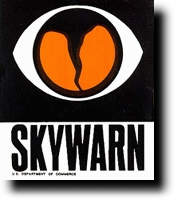South Plains Storm Spotting Team
Frequently Asked Questions
What is Storm Spotting?
Storm spotters are usually people within a local community that are trained and report to local weather service personnel or Emergency Management agencies from their homes, offices, or predefined field locations. They can be stationary spotters or mobile spotters operating from their vehicles. Spotters usually stay within the borders of the county they serve whereas chasers roam the landscape crossing county and state lines. Both these activities can be very dangerous. You should have extensive severe weather safety training before engaging in spotting or chasing storms. Like chasers, spotters should have dependable transportation, reliable communications (cell phones are not reliable in remote areas) and a method of obtaining accurate storm information.
What is SKYWARN?
The effects of severe weather are felt every year by many Americans. To obtain critical weather information,
NOAA's National Weather Service (NWS), part of the U.S. Department of Commerce, established SKYWARN with
partner organizations. SKYWARN is a volunteer program with over 230,000 trained severe weather spotters.
These volunteers help keep their local communities safe by providing timely and accurate reports of severe weather to the National Weather Service. Although SKYWARN spotters provide essential information for all types of weather hazards, the main responsibility of a SKYWARN spotter is to identify and describe severe local storms. In the average year, 10,000 severe thunderstorms, 5,000 floods and more than 1,000 tornadoes occur across the United States. These events threaten lives and property. Since the program started in the 1970s, the information provided by SKYWARN spotters, coupled with Doppler radar technology, improved satellite and other data, has enabled NWS to issue more timely and accurate warnings for tornadoes, severe thunderstorms and flash floods. SKYWARN storm spotters are part of the ranks of citizens who form the Nation's first line of defense against severe weather. There can be no finer reward than to know that their efforts have given communities the precious gift of time--seconds and minutes that can help save lives.
What does a Spotter do?
The National Weather Service has a great deal of advanced technology for detecting thunderstorms including radar, satellite, balloons, surface data, and lightning strike detection networks. Even with all this technology, the most important tool for observing severe storms is the trained eye of a storm spotter. Trained spotters travel to areas of severe weather and make observations of the storm structure and motion and report these to Net Controllers, with local emergency management, who relay them to the National Weather Service. One example of how a storm spotter aids the NWS is reporting actual tornado conditions. If radar indicates circulation in a storm and a spotter confirms rotation at the cloud base, then in most circumstances a tornado warning would be issued. However, if the radar suggests rotation and the spotter does not see evidence of the rotation, the warning might be held off until conditions change. This improves the accuracy of tornado warnings issued by the NWS.
Using Amateur Radio in Storm Chasing/Spotting:
Amateur Radio (ham radio) works as a key communication system during emergency situations. It is very important to storm spotters and chasers in the field. With an amateur radio license, proper equipment, and training you can transmit your reports directly to the National Weather Service or local emergency management agency. Amateur Radio is a must for communications between cars and other chasers. Cell phones are often useless in remote areas and CB radios are not a good means of communication due to very low power and no system of repeaters. The State of Oklahoma, for example, has a linked amateur radio repeater system that allows spotters and chasers who are licensed radio operators to receive and share information throughout the state while remaining on one frequency.


